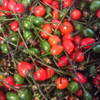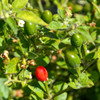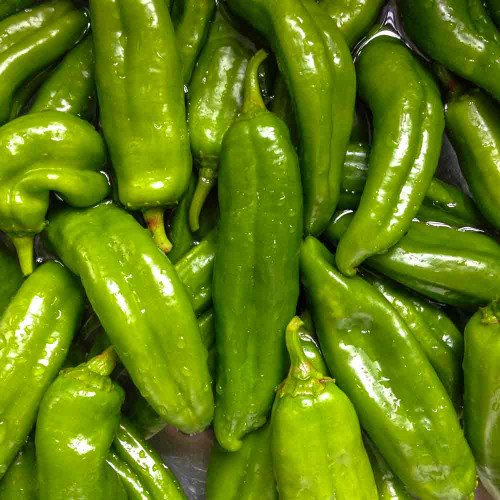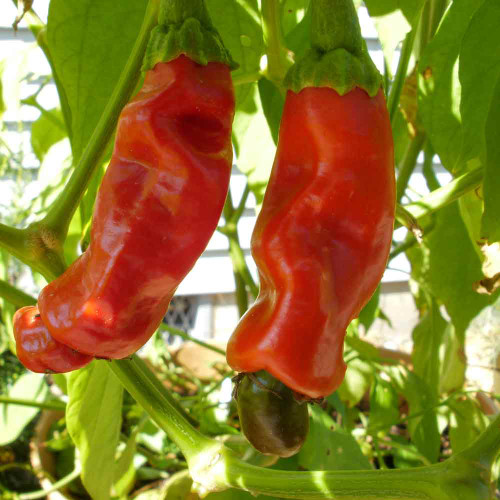Description
Chiltepin Pepper - Mother of All Peppers
Looking more like a small round berry than a chile, the Chiltepin – pronounced “chill tuh peen” – is one of the oldest and few remaining wild chiles. Often called the "Mother of All Peppers," this ancestor of countless domesticated varieties is the only wild chile native to the United States. Still growing wild on shrubs under nurse plants in canyons throughout the Southwest and northern Mexico, this tiny but mighty pepper packs a flavorful punch. Bite into a fiery red Chiltepin: the heat arrives first, intense and unapologetic, before melting away to reveal complex fruity and smoky undertones. This dynamic flavor and its fascinating history make the Chiltepin a must-have for any adventurous gardener.
Details
This tiny chile is a small, intensely flavored pepper with a big personality. This unique pepper has many names, reflecting its long history and wide distribution, including chile tepin, bird pepper, pequin pepper, and many more. Its most common name, Chiltepin, comes from the Nahuatl language, combining "chil-" (chile pepper) and "-tecpintl" (flea), referring to its small size.
The wild chile typically grows as a medium-sized, woody shrub, reaching heights and widths of up to 5 feet, though it can grow larger in ideal conditions. It has a moderate growth rate and tends to spread, making it a visually appealing addition to any garden. The leaves are an attractive teardrop shape, adding to the plant's ornamental appeal, and are arranged alternately on the stem. The fruit is a small, spherical berry, about 1/3 inch in diameter. The berries put on a striking show, ripening from green through orange-red to an eye-catching scarlet red. Each fruit contains many very small, disk-shaped seeds.
The flavor is complex and dynamic. On first taste, the heat is intense and unapologetic, coming on fast and strong – the flavor introduces itself later. This initial burst of intense heat (50,000 to 100,000 Scoville Heat Units, similar to Thai or Malagueta chiles) quickly gives way to fruity and citrusy notes, finishing with a distinctive toasted or smoky essence, described as “the lingering taste of the thirsty desert itself” by Dr. Gary Nabhan in his book Chasing Chiles. This rapid heat distinguishes it from other chiles with a slower, more enduring burn.
I've known this little heat bomb since I was a boy growing up in the Colorado mountains. I remember an old Italian man who always carried a bag of these dark red, pea-sized peppers, eating them like snacks. He was a gruff but kind fellow, and the chiltepins fascinated me. Years later, I rediscovered them and developed a true appreciation for their hot yet flavorful character. They make an excellent roasted salsa with fresh vegetables and a couple of milder chiles. The heat arrives first, right on the tip of your tongue, and then the other flavors arrive as the heat drops. Then, inevitably, you reach for another, and another, caught in the interplay of heat and flavor.
Wild chiltepins can live for 35-50 years in frost-free regions, becoming sizable shrubs. This pepper thrives in well-drained soils and prefers partial shade, especially in hot climates. In its natural habitat, it often grows under "nurse" trees like mesquite or hackberry, which provide dappled shade and protection from the intense desert sun. It prefers xeroriparian areas, which are dry areas near water sources. While these plants can tolerate drought, supplemental irrigation can increase yields, but avoid overwatering. The Chiltepin pepper is hardy in USDA Hardiness Zones 9a-10a and grown as an annual everywhere else. It's a tender perennial, meaning it can survive mild winters but will die back to the ground with frost in colder climates.
History
The ancestor of many chiles likely originated in southern Brazil or Bolivia, traveling north through Central America and Mexico, eventually reaching the American Southwest, largely thanks to wild birds. Unaffected by the heat, they relish the scarlet berries, distributing seeds far and wide through their droppings. This natural process has resulted in wild Chiltepins thriving along fence rows, under trees, and across the landscape. Evidence suggests the Chiltepin was domesticated in east-central Mexico between 7,000 and 9,000 BC, potentially making it the first domesticated pepper in the Americas, reflecting its deep roots in human history.
While the Aztecs gave it its most common name, the Chiltepin has a long history with indigenous peoples from Central America to the southwestern U.S., who used it to spice food, as a preservative, and as medicine. Thomas Jefferson even grew Chiltepins in his garden after acquiring seeds from Captain Samuel Brown in San Antonio, Texas, in 1812. European explorers introduced it to the Old World in the late 16th century, and in 1997, Texas named it the official state native pepper.
The U.S. Forest Service established the Wild Chile Botanical Area to protect the largest concentration of Chiltepin plants in the U.S., located in the Tumacacori Mountains in southern Arizona. More specifically, it's situated in Rock Corral Canyon, north of the Arizona-Sonora border. This area, also known as the Wild Chile Reserve, has approximately 2,500 acres. The Forest Service actively manages the Wild Chile Botanical Area to preserve the genetic diversity of the Chiltepin and protect its natural habitat. Their efforts include controlling invasive species, monitoring the health of the Chiltepin populations, and educating the public about the importance of this unique chile.
Uses
Chiltepins are versatile, lending their fiery kick and smoky flavor to a wide range of dishes. They can be used fresh, dried, or pickled. Dried Chiltepins can be crushed and used as a spice in salsas, soups, stews, and marinades. Fresh peppers add their distinctive heat to salsas, both fresh and roasted. Pickled Chiltepins, crushed and mixed with wild oregano, garlic, and salt, make a tangy condiment perfect for tacos, sandwiches, and grilled meats. Infused in olive oil, they create a spicy drizzle for pizzas, pasta, or vegetables. They can even be fermented into hot sauce, added to cheeses and ice cream for a surprising twist, or incorporated into chocolate desserts and spicy jams.
Traditionally, Chiltepins were used to preserve meat and are still featured in a traditional Sonoran dish with wild greens and onions. Beyond kitchen uses, Chiltepins have a history in traditional medicine, used for pain relief, digestion, and even rheumatism. The Pima Bajo people used them for stomach disorders, while the Mayo Indians made a liniment from the leaves. The Tarahumara chewed them with other plants for headaches. While historically used when ripe and red, some chefs now experiment with the green stage for a different flavor profile. Green chiltepins tend to have a brighter, more herbaceous flavor, while red ones are sweeter and smokier. Dried Chiltepins are often sun-dried and crumbled, used like chile flakes, or rehydrated in water or vinegar to create a flavorful chile water. In Mexico, they're often paired with fish, their quick heat reminiscent of wasabi.
Companion Planting
Beneficial pairings for Chiltepins include basil and nasturtium, which repel aphids and whiteflies. Onions and garlic are also beneficial companions, as they deter aphids, beetles, and fungal diseases. Marjoram and oregano provide ground cover and retain soil moisture, creating a favorable environment for Chiltepins. Strawberries loosen the soil and benefit from the nitrogen-rich environment preferred by Chiltepins. Planting Chiltepins near other hot pepper plants can provide shade and protect fruits from excessive sun exposure.
Avoid planting Chiltepins near eggplant, peas, fennel, beets, potatoes, and celery. These plants can attract similar pests or compete for the same nutrients, potentially hindering the growth and yield of this unique pepper.
Planting and Growing Tips
Chiltepins thrive in partially shaded to shady locations with slightly more moisture than some other chiles, making them ideal companions for garden vegetables like tomatoes, trellised peas, or corn, which can act as "nurse plants." They also grow well in large pots, often living for several years if brought indoors during winter—a garage with low, but not freezing, temperatures is ideal for overwintering, though they may lose their leaves.
Start seeds indoors 8-12 weeks before the last frost, using a sterile seed-starting mix and bottom heat (80-90°F). Lightly sanding the seeds or soaking them for a few hours in a mixture of water and a drop of vinegar can improve germination. Transplant seedlings with six true leaves into larger pots (at least 6 inches in diameter) or the garden, spacing them 30 inches apart. Partial shade is crucial, especially in hotter climates; a south-facing wall can offer protection and create a suitable microclimate. Water moderately, letting the soil dry slightly between waterings. In colder regions, container growing is recommended for easy relocation indoors. Prune any frost damage to encourage bushier growth. Avoid peat pots, as they can create an unsuitable acidic environment. Use fresh Chiltepin seeds for best germination rates, as they can lose viability over time.
Harvest Tips
Harvest your Chiltepins in the morning after the dew has dried. Begin harvesting when the peppers turn a vibrant red and easily detach from the stem. Continue harvesting until the first frost. A traditional chiltepinaro tool can be used to grind the dried peppers. When using a coffee grinder to grind dried peppers, let the ground pepper settle before opening the grinder to avoid the potent dust. Use gloves to harvest and handle fresh chiles, as the capsaicin can linger on your fingers for hours, causing unexpected burns to eyes and sensitive skin. Store dried chiltepins in an airtight container in a cool, dark place to maintain their flavor.
Learn More
- Growing Peppers 101
- Chile and Pepper Growing Tips
- Grow Better Peppers with Shade
- Fermented Pepper Sauce
- Fermented Chile Paste
From the soil to the seed to the food you eat - we'll help you grow your best garden!
1 Review
-
I can attest
I can attest to the extreme heat of these tiny chilies! Even though they've been a part of my life since birth, I shied away from them because I ate a baby handful of them at age 4. My parents took me to the E.R., had my stomach pumped & then had me anethethsetized because of my extreme reaction. Hey! I WAS ONLY 4! My next exposure to them came about 25 years later, oddly enough in Germany. Long story short, I thought that they were regular crushed red peppers. The heat was immediate & overwhelming. It rose to a crescendo of pain & panic, even gustatory sweating, which I had never experienced before. After I had recovered somewhat, I asked the proprietor which chile they were. She told me that they came from Mexico & were the size of a pea. Then I knew what I was dealing with. She gave me a glass of whole milk chocolate milk & I womaned up & finished my food. I have since been able to eat these without the extreme reaction. I will sometimes keep a glass of chocolate milk at my seat. My favorite way to use them is in hot chile oil. Add a couple of tablespoons of that chile oil to whatever you're cooking for a great tasting, HOT burst of flavor.























